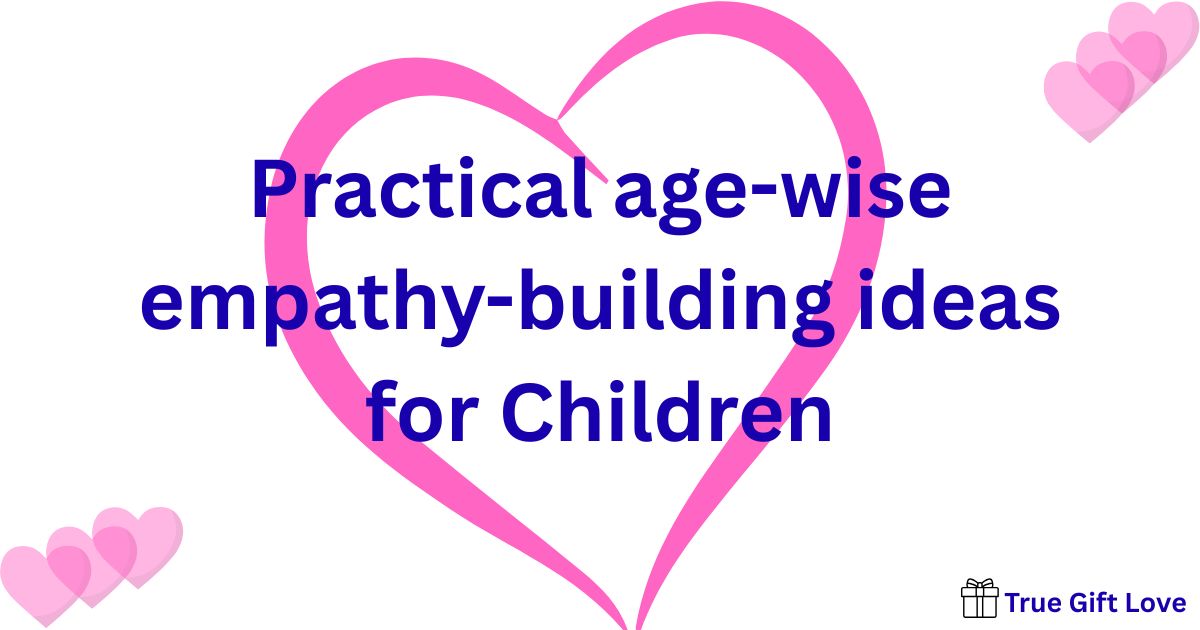Introduction: What Empathy Is and Why It Matters
Empathy is more than being nice.
It’s the ability to understand how someone else feels and respond with care.
For children, empathy is a core social–emotional skill that directly shapes:
- friendship quality
- emotional resilience
- conflict resolution
- self-regulation and compassion
Research from child development, SEL frameworks (e.g., CASEL), and neuroscience clearly shows:
Empathy is not fixed; it grows with practice, modeling, and experiences.
Just like reading or math, empathy can be taught, strengthened, and woven into daily routines.
And that’s where your role as parent, caregiver, educator becomes powerful.
Universal Empathy Teaching Moves (Works at ANY Age)
These always strategies build the foundational soil.
| Strategy | What it looks like daily |
| Model empathy out loud | Name others’ feelings and your own: Looks like she felt disappointed when she didn’t get a turn. |
| Emotion language practice | Expand beyond happy-sad-mad: introduce frustrated, nervous, proud, left out. |
| Let kids help | Helping with chores, comforting, making a card doing empathy shapes neural pathways. |
| Praise the process | Celebrate noticing, trying, comforting: I love how you paused to check if he was okay. |
| Use stories + media | Books, cartoons, and real-life moments → reflect on characters’ feelings. |
| Repair moments | Teach how to make amends: What can we do to help this feel better? |
Age-Sorted Empathy Practices & Ideas
Ages 3–5: Naming Feelings + Simple Comforting
At this age, empathy starts with noticing facial expressions and basic emotions.
Activities
- Emotion Faces Sorting (happy, sad, scared, mad images)
- Feelings Check with mirror time
- Stuffed animals rescue play (Oh no! Teddy is crying! What can we do?)
Conversation Prompts
- Which face do you think he is making?
- What could help her feel better?
Book Picks
- The Rabbit Listened — Cori Doerrfeld
- In My Heart — Jo Witek
Ages 5–7: Perspective Taking Begins
Kids now understand that other people can think differently.
Activities
- Switch Seats storytelling tells the same story from two characters
- Prediction game: What might happen next… and how will she feel?
- Compliment Coupons for classmates
Conversation Prompts
- What do you think he wanted?
- Does your friend like that the same way you do?
Book Picks
- Be Kind — Pat Zietlow Miller
- A Little Spot of Empathy — Diane Alber
Ages 7–9: Nuanced Emotions + Group Belonging
Children now get complex feelings: embarrassed, excluded, proud, overwhelmed.
Activities
- Feelings Weather Report (sunny/tornado/drizzle)
- Opinion swapping: choose a snack/activity → argue the other side
- Kindness Buddies challenge (help the same friend all week)
Conversation Prompts
- Have you ever felt that way before?
- What clue helped you figure out how he felt?
Book Picks
- Each Kindness — Jacqueline Woodson
- The Invisible Boy — Trudy Ludwig
Ages 9–11: Moral Empathy + Responsibility
Pre-teens can reflect on fairness, bias, and social justice in simple ways.
Activities
- Complaints → Solutions chart
- Classroom or sibling mediators rotation
- Research project: How kids in another place live
Conversation Prompts
- Whose perspective is missing here?
- What would be the kind thing even if it’s not the easy thing?
Book Picks
- Wonder — R. J. Palacio
- Those Shoes — Maribeth Boelts
Age 12+: Social Identity + Empathy in Complexity
Now empathy stretches beyond friends → towards groups, world events, fairness, equity.
Activities
- Digital empathy challenge: Respond kindly to 3 online posts daily
- Run a peer support station at school
- Host a family issue debate — but start with:
What is one good reason someone might think the opposite?
Conversation Prompts
- Where did your assumption come from?
- What responsibility do we have to the ‘outsider’ in a story?
Book Picks
- Stampede (For Kids) — Jason Reynolds & Ibram X. Kendi
- The Hate U Give — Angie Thomas (teen/YA)
Optional Family Challenge: The 7-Day Heart Habit
Try this one-week mini challenge:
| Day | Heart Habit |
| 1 | Say one kind guess about someone’s feelings |
| 2 | Give one unexpected compliment |
| 3 | Offer help before being asked |
| 4 | Make a thank-you note |
| 5 | Comfort someone sad or frustrated |
| 6 | Share a story of when YOU needed empathy |
| 7 | Celebrate how empathy felt all week |
You can print it, post it on the fridge, or make it a classroom poster.
Practical Takeaways
- Empathy grows in tiny, daily moments — not lectures.
- Language → labels the invisible → makes it learnable.
- When children see empathy modeled + praised, they begin practicing it spontaneously.
- Books, stories, and reflection are the most natural training tools.
FAQs
1) Why is empathy important for children?
Empathy helps kids build stronger friendships, reduces bullying, and improves emotional intelligence. Research shows children who practice empathy are more confident, resilient, and socially skilled.
2) Is empathy a skill or a personality trait?
Empathy is a skill. Some children may show it naturally, but every child can learn, strengthen, and practice empathy through modeling, conversations, and supportive experiences.
3) How can parents teach empathy at home?
Model empathy in daily interactions, ask reflective feeling questions, read books that show emotions, and praise thoughtful behavior. Small repeated acts build empathy like a habit.
4) What are simple empathy activities for kids?
Emotion face cards, helping a sibling, noticing when someone needs comfort, writing thank you notes, doing a kindness challenge, or talking about characters’ feelings in stories.
5) Which books encourage empathy in children?
Popular empathy-building books include The Rabbit Listened, Be Kind, Each Kindness, Wonder, and The Invisible Boy. These books spark deep conversations about feelings and kindness.
6) How can teachers encourage empathy in the classroom?
Use perspective-taking activities, class jobs that help others, role-plays, SEL circles, and stories. Celebrate empathetic actions publicly so students see it as the norm.
7) Can empathy be taught to teenagers, too?
Yes. Teens benefit from discussions around identity, fairness, online kindness, and real-life community issues. Digital empathy challenges work great for teens.
Conclusion: Empathy is a Lifelong Skill
Children are not just born empathetic.
They learn it through experience, co-regulation, safe attachment, practice, and guided reflection.
Keep the tone gentle.
Keep opportunities frequent.
Keep modeling what it looks like.




